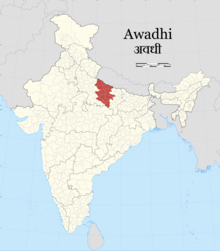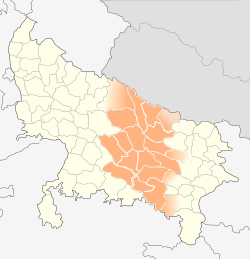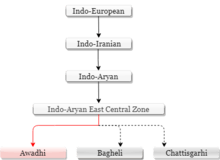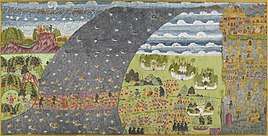Awadhi language
Awadhi (IPA: [əʋ.d̪ʱiː]; अवधी; 𑂃𑂫𑂡𑂲) is an Eastern Hindi language of the Indo-Aryan branch spoken in northern India.[4][5] It is primarily spoken in the Awadh region of present-day Uttar Pradesh, India.[4] The name Awadh is connected to Ayodhya, the ancient town, which is regarded as the homeland of Śrī Rāma. It was, along with Braj Bhasha, used widely as a literary vehicle before being displaced by Hindustani in the 19th century.[6]
| Awadhi | |
|---|---|
| Avadhī | |
| अवधी • 𑂃𑂫𑂡𑂲 | |
 'Awadhi' written in Kaithi (top) and Devanagari (bottom) scripts. | |
| Pronunciation | [əʋ.d̪ʱiː] |
| Native to | India and Nepal |
| Region | Awadh (India) Terai (Nepal) |
| Ethnicity | Awadhis |
Native speakers | 3.85 million (India, 2011)[1] 501,752 (Nepal, 2011)[2] |
Indo-European
| |
| Dialects |
|
| |
| Official status | |
Official language in | |
| Language codes | |
| ISO 639-2 | awa |
| ISO 639-3 | awa |
| Glottolog | awad1243[3] |
| Linguasphere | 59-AAF-ra |
 | |
Linguistically, Awadhi is a language at par with Hindustani. However, it is regarded by the state to be a dialect of Hindi, and the area where Awadhi is spoken to be a part of the Hindi-language area owing to their cultural proximity. As a result, Modern Standard Hindi, rather than Awadhi, is used for school instructions as well as administrative and official purposes; and its literature falls within the scope of Hindi literature.[7]
Alternative names of Awadhi include Baiswāri (after the subregion of Baiswara),[8] as well as the sometimes ambiguous Pūrbī, literally meaning "eastern", and Kōsalī (named after the ancient Kosala Kingdom).[4]
Geographic distribution
In India
Awadhi is predominantly spoken in the Awadh region encompassing central Uttar Pradesh, along with the lower part of the Ganga-Yamuna doab.[4][9] In the west, it is bounded by Western Hindi, specifically Kannauji and Bundeli, while in the east there is the Bihari dialect Bhojpuri. In the north, it is bounded by the country of Nepal and in the south by Bagheli, which shares a great resemblance with Awadhi.[10]
The districts of Lakhimpur Kheri, Sitapur, Lucknow, Unnao, and Fatehpur form the western parts of the Awadhi-speaking area. The central districts include Barabanki, Rae Bareli, Amethi, and Baharich. The eastern parts include districts of Faizabad, Allahabad, Kaushambi, Gonda, Basti, Sultanpur, Ambedkar Nagar, and Pratapgarh. It is also spoken in some parts of Mirzapur, Azamgarh and Jaunpur districts.[9]

In Nepal
Awadhi is spoken in these parts of Nepal: Bheri zone: Banke and Bardia districts; Lumbini zone: Kapilvastu, Nawalparasi, and Rupandehi districts; Mahakali zone: Kanchanpur district; Rapti zone: Dang district; Seti zone: Kailali district.[11]
Outside South Asia
A language influenced by Awadhi (as well as other languages) is also spoken as a lingua franca for Indians in Fiji and is referred to as Fijian Hindi. According to Ethnologue, it is a type of Awadhi influenced by Bhojpuri and is also classified as Eastern-Hindi.[12] Another language influenced by Awadhi (and Bhojpuri) is Caribbean Hindustani, spoken by Indians in the Caribbean countries of Trinidad and Tobago, Suriname, and Guyana. The Hindustani that is spoken in South Africa and Mauritius is also partly influenced by Awadhi.These forms of Awadhi are also spoken by the diaspora in North America, Europe, and Oceania.
Classification

Awadhi is an Indo-European language and belongs to the Indo-Aryan sub-group of the Indo-Iranian language family. Within the Indo-Aryan dialect continuum, it falls under the East-Central zone of languages and is often recognized as Eastern-Hindi. It’s generally believed that an older form of Ardhamagadhi, which agreed partly with Sauraseni and partly with Magadhi Prakrit, could be the basis of Awadhi.[13]
The closest relative of Awadhi is the Bagheli language as genealogically both descend from the same 'Half-Magadhi'. Most early Indian linguists regarded Bagheli merely as 'the southern form of Awadhi', but recent studies accept Bagheli as a separate dialect at par with Awadhi and not merely a sub-dialect of it.[14]
Phonology
Vowels
Awadhi possesses both voiced and voiceless vowels. The voiced vowels are: /ʌ/, /aː/, /ɪ/, /iː/, /ʊ/, /uː/, /e/, /eː/, /o/, /oː/.[15] The voiceless vowels, also described as "whispered vowels" are: /i̥/, /ʊ̥/, /e̥/.[16]
Consonants
| Bilabial | Dental/ | Retroflex | Palatal | Velar | Glottal | ||
|---|---|---|---|---|---|---|---|
| Nasal | m | n | (ɳ) | (ɲ) | (ŋ) | ||
| Plosive | voiceless | p | t | ʈ | tʃ | k | |
| voiceless aspirated | pʰ | tʰ | ʈʰ | tʃʰ | kʰ | ||
| Affricate | voiced | b | d | ɖ | dʒ | ɡ | |
| voiced aspirated | bʱ | dʱ | ɖʱ | dʒʱ | ɡʱ | ||
| Fricative | voiceless | s | h | ||||
| voiced | ɦ | ||||||
| Flap | plain | ɽ | |||||
| voiced aspirated | ɽʱ | ||||||
| Trill | r | ||||||
| Approximant | ʋ | j | |||||
| Lateral Approximant | l | ||||||
Grammar
Comparative grammar
Awadhi has many features that separate it from the neighboring Western Hindi and Bihari vernaculars. In Awadhi, nouns are generally both short and long, where Western Hindi has generally short while Bihari generally employs longer and long forms. The gender is rigorously maintained in Western Hindi, Awadhi is a little loose yet largely preserved, while Bihari is highly attenuated. Regarding to postpositions, Awadhi is distinguished from Western Hindi by the absence of agentive postposition in the former, agreeing with Bihari dialects. The accusative-dative postposition in Awadhi is /kaː/ or /kə/ while Western Hindi has /koː/ or /kɔː/ and Bihari has /keː/. The locative postposition in both Bihari and Western Hindi is /mẽː/ while Awadhi has /maː/. The pronouns in Awadhi have /toːɾ-/, /moːɾ-/ as personal genitives while /teːɾ-/, /meːɾ-/ are used in Western Hindi. The oblique of /ɦəmaːɾ/ is /ɦəmɾeː/ in Awadhi while it is /ɦəmaːɾeː/ in Western Hindi and /ɦəmrən'kæ/ in Bihari.[6]
Another defining characteristic of Awadhi is the affix /-ɪs/ as in /dɪɦɪs/, /maːɾɪs/ etc. The neighbouring Bhojpuri has the distinctive (i) /laː/ enclitic in present tense (ii) /-l/ in past tense (iii) dative postposition /-laː/ which separates it from the Awadhi language.[13]
Pronouns
| Singular 'I/me/my' | Plural 'we/us/our' | |||||||||
|---|---|---|---|---|---|---|---|---|---|---|
| Dir. | Ag. | Obl. | Dat. | Gen. | Dir. | Ag. | Obl. | Dat. | Gen. | |
| Modern Standard Hindi | mãĩ मैं | mãĩ'nē मैंने | mujh मुझ | mujhē मुझे | mērā* मेरा | ham हम | ham'nē हमने | ham हम | hamē̃ हमें | hamārā* हमारा |
| Awadhi | mai (mãy) मै | - | ma(h)i महि | - | mōr* मोर | ham हम | - | ham हम | hamai हमै | hamār* हमार |
| (Substitute or other forms in Awadhi) | - | - | mō मो | mai'kā मइका, mō'kā मोका | - | - | - | - | ham'kā हमका | - |
|
Singular |
Plural | |||||||||||
|---|---|---|---|---|---|---|---|---|---|---|---|---|
| Dir. | Ag. | Obl. | Dat. | Gen. | Hon. | Dir. | Ag. | Obl. | Dat. | Gen. | Hon. | |
| Modern Standard Hindi | tū | tū'nē | tujh | tujhē | tērā* | - | tum | tum'nē | tum | tumhē̃ | tumhārā* | āp– |
| Awadhi | tū, tui (toi), taĩ (tãy) | - | tu(h)i | - | tōr* | āpu̥ | tum | - | tum | tumai, tohaĩ (tohãy) | tumār*/tohār* | āp– |
| (Substitute or other forms in Awadhi) | - | - | tō | tui'kā, tō'kā (tõh'kā) | - | - | - | - | tum'kā | - | - | |
- Notes:
Literature
Late-medieval and early-modern India
In this period, Awadhi became the vehicle for epic poetry in northern India.[20] Its literature is mainly divided into: bhaktīkāvya (devotional poetry) and premākhyān (romantic tales).
Bhaktīkāvyas
The most important work, probably in any modern Indo-Aryan language, came from the poet-saint Tulsidas in the form of Ramcharitmanas (1575 C.E.) or "The Lake of the Deeds of Rama", written in doha-chaupai metre. Its plot is mostly derivative, either from the original Rāmāyaṇa by Valmiki or from the Adhyātma Rāmāyaṇa, both of which are in Sanskrit.[21] Mahatma Gandhi had acclaimed the Ramchairtmanas as "the greatest book of all devotional literature" while western observers have christened it as "the Bible of Northern India".[22] It is sometimes synonymously referred as 'Tulsidas Ramayana' or simply 'the Ramayana'.[23]
Tulsidas's compositions Hanuman Chalisa,[24][25][26] Pārvatī Maṅgala and Jānakī Maṅgala are also written in Awadhi.[27]
अंडकोस प्रति प्रति निज रूपा। |
In each universe I saw my own self, |
| —Tulsidas, 7.81.3 chaupai, Ramcharitmanas | —Translation by R.C Prasad[28] |
सिंधु तीर एक भूधर सुंदर। |
On the sea-shore there was a mountain lovely, |
| —Tulsidas, 5.1.3 chaupai, Ramcharitmanas | —Translation [29] |
The first Hindi vernacular adaptation of the 'Dasam Skandha' of the Bhagavata Purana, the “Haricharit” by Lalachdas, who hailed from Hastigram (present-day Hathgaon near Rae Bareilly), was concluded in 1530 C.E. It circulated widely for a long time and scores of manuscript copies of the text have been found as far as eastern Uttar Pradesh and Bihar, Malwa and Gujarat, all written in the Kaithi script.[30]
Satyavatī (ca. 1501) of Ishvaradas (of Delhi) under the reign of Sikander Lodi and Avadhabilāsa (1700 C.E.) of Laladas were also written in Awadhi.
Awadhi appeared as a major component in the works of Bhakti saints like Kabir, who used a language often described as being a pancmel khicṛī or "a hotch-potch" of several vernaculars.[31][32] The language of Kabir's major work Bijak is primarily Awadhi.[33][34]
Premākhyāns
Awadhi also emerged as the favorite literary language of the Eastern Sufis from the last quarter of the 14th century onwards. It became the language of premākhyāns, romantic tales built on the pattern of Persian masnavi, steeped in Sufi mysticism but set in a purely Indian background, with a large number of motifs directly borrowed from Indian lore. The first of such premākhyān in the Awadhi language was Candāyan (1379 C.E.) of Maulana Da'ud.[35] The tradition was carried forward by Jayasi, whose masterpiece, the Padmāvat (1540 C.E.) was composed under the reign of the famous ruler Sher Shah Suri. The Padmavat travelled far and wide, from Arakan to the Deccan, and was eagerly copied and retold in Persian and other languages.[36]
Other prominent works of Jayasi—Kānhāvat,[37] Akhrāvaṭ[27] and Ākhrī Kalām[38] are also written in Awadhi.
I’ll tell you about my great town, the ever-beautiful Jais.
In the satyayuga it was a holy place, then it was called the “Town of Gardens.”
Then the treta went, and when the dvapara came, there was a great rishi called Bhunjaraja.
88,000 rishis lived here then, and dense … and eighty-four ponds.
They baked bricks to make solid ghats, and dug eight-four wells.
Here and there they built handsome forts, at night they looked like stars in the sky.
They also put up several orchards with temples on top.
Doha: They sat there doing tapas, all those human avataras.They crossed this world doing homa and japa day and night.
The Awadhi romance Mirigāvatī (ca.1503) or "The Magic Doe", was written by Shaikh 'Qutban' Suhravardi, who was an expert and storyteller attached to the court-in-exile of Sultan Hussain Shah Sharqi of Jaunpur.[40][41] Another romance named Madhumālatī or "Night Flowering Jasmine" by poet Sayyid Manjhan Rajgiri was written in 1545 C.E.[42]
Amir Khusrau (d. 1379 C.E) is also said to have written some compositions in Awadhi.[43]
Modern India
The most significant contributions to the Awadhi literature in the modern period have come from writers like Ramai Kaka (1915-1982 C.E.), Balbhadra Prasad Dikshit better known as ‘Padhees’(1898-1943 C.E.) and Vanshidhar Shukla (1904-1980 C.E.).
‘Krishnayan’ (1942 C.E.) is a major Awadhi epic-poem that Dwarka Prasad Mishra wrote in imprisonment during the Freedom Movement of India.
Popular culture
Entertainment
The 1961 film Gunga Jumna features Awadhi being spoken by the characters in a neutralised form. In the 2001 film Lagaan, a neutralised form of Awadhi language was used to make it understandable to audiences.[44][45] The 2009 film Dev.D features an Awadhi song, "Paayaliya", composed by Amit Trivedi.[46] In the television series Yudh, Amitabh Bachchan spoke parts of his dialogue in Awadhi, which received critical acclaim from the Hindustan Times.[47] Awadhi is also spoken by the residents of Ayodhya and other minor characters in Ramanand Sagar's 1987 television series Ramayan.
Sample phrases
The Awadhi language comes with its dialectal variations. For instance, in western regions, the auxiliary /hʌiː/ is used, while in central and eastern parts /ʌhʌiː/ is used.
The following examples were taken from Baburam Saxena's Evolution of Awadhi, and alternative versions are also provided to show dialectal variations.
| English | Awadhi (IPA) | Awadhi (Devanagari) |
|---|---|---|
| Who were there? | ɦʊãː koː or kəʊn ɾəɦəĩ | हुआँ को (कउन) रहें? |
| alt. ɦʊãː keː or kəʊn ɾəɦəin | alt. हुआँ के/कउन रहेन? | |
| This boy is fine in seeing and hearing. | ɪʊ lʌɾɪkaː d̪eːkʰʌiː sʊnʌiː mə ʈʰiːk hʌiː | इउ लरिका देखई सुनई म ठीक है। |
| alt. ɪ lʌɾɪkaː d̪eːkʰʌiː sʊnʌiː mə ʈʰiːk ʌhʌiː | alt. इ लरिका देखई सुनई म ठीक अहै। | |
| (She) said, let (me) eat a little and give a little to this one too. | kʌɦɪn laːoː t̪ʰoːɽaː kʰaːɪ leːiː t̪ʰoːɽaː jʌhu kɘ d̪ʌɪ d̪eːiː | कहिन, लाओ थोड़ा खाई लेई, थोड़ा यहु का दै देई। |
| alt. kʌɦɪn lyaːvː t̪ʰoːɽaː kʰaːɪ leːiː raːçi keː jʌnhu kɘ d̪ʌɪ d̪eːiː | alt. कहिन, ल्याव थोड़ा खाई लेई, रचि के एन्हुं के दै देई। | |
| Those who go will be beaten. | d͡ʒoː d͡ʒʌɪɦʌĩ soː maːrʊ̥ kʰʌɪɦʌĩ | जो जइहैं सो मारउ खइहैं। |
| alt. d͡ʒèː d͡ʒʌɪɦʌĩ soː maːr kʰʌɪɦʌĩ | alt. जे जइहैं सो मार खइहैं। | |
| Do not shoot at the birds. | cɪɾʌɪjʌn pʌɾ chʌrːaː nə cʌlaːoː | चिरइयन पर छर्रा न चलाओ। |
| alt. cɪɾʌɪjʌn peː chʌrːaː jin cʌlaːwː | alt. चिरइयन पे छर्रा जिन चलाव। |
See also
- Awadh
- Bagheli language
- Fijian Hindustani
- Caribbean Hindustani
Footnotes
- "Statement 1: Abstract of speakers' strength of languages and mother tongues - 2011" (PDF). www.censusindia.gov.in. Office of the Registrar General & Census Commissioner, India. Retrieved 7 July 2018.
- http://unstats.un.org/unsd/demographic/sources/census/wphc/Nepal/Nepal-Census-2011-Vol1.pdf
- Hammarström, Harald; Forkel, Robert; Haspelmath, Martin, eds. (2017). "Awadhi". Glottolog 3.0. Jena, Germany: Max Planck Institute for the Science of Human History.
- Saxena (1971:1)
- Grierson (1904:1)
- Saxena (1971:6)
- Masica (1993:9)- A vast central portion of the subcontinent, consisting of the Indian states of Uttar Pradesh, Bihar, Madhya Pradesh, Rajasthan, Haryana, and Himachal Pradesh, plus the Union Territory of Delhi, is known as the "HINDI area", because the official and general written language, that is to say, that of administration, press, school instruction, and modern literature, is Hindi, sometimes called MODERN STANDARD HINDI, and the whole area is heir to the "Hindi literary tradition" – Hindi being used here in a different and wider sense, to refer to pre-modern literatures in Braj and Awadhi, and often to those languages proper to Rajasthan and Bihar as well
- Grierson (1904:10)
- Grierson (1904:9–10)
- Saxena (1971:2–5)
- "Awadhi". Ethnologue. Retrieved 7 February 2019.
- "Fiji Hindi". Ethnologue. Retrieved 26 November 2017.
- Grierson (1904:2)
- Mandal, R. B. (1990). Patterns of Regional Geography: Indian perspective. Concept Publishing Company. pp. 127–129. ISBN 978-81-7022-291-0.
- Saxena (1971:23)
- Greenberg, Joseph Harold; Kemmer, Suzanne (1990). On Language: Selected Writings of Joseph H. Greenberg. Stanford University Press. pp. 85. ISBN 9780804716130.
awadhi.
- Masica (1993:252)
- Grierson, G. A. (1967). Linguistic Survey of India. The Long Now Foundation. Motilal Banarsidass.
- Saxena (1971:169)
- Grierson (1904:13)
- Saxena (1971:11–12)
- Lutgendorf (1991:1)
- Lutgendorf (1991:12)—Since the Ramcaritmanas is a text in the Ramayana tradition, for which the Sanskrit epic of Valmiki is the accepted archetype, it is commonly referred to simply as "the Ramayan" and many popular editions bear only this name on their spine and cover, perhaps adding above it in small print: "composed by Goswami Tulsidas".
- Padam, Sandeep (21 March 2018). Hanuman Chalisa: Verse by Verse Description (in Hindi). Notion Press. ISBN 978-1-64249-611-6.
- Shamim, Dr Rupali Saran Mirza Dr and Amna (14 November 2016). Lucknow Poetica. Idea Publishing. p. 42.
- Vishwananda, Paramahamsa Sri Swami (13 March 2018). Sri Hanuman Chalisa: Commentary on the Praises to the Eternal Servant. BoD – Books on Demand. p. 11. ISBN 978-3-96343-015-2.
- Saxena (1971:12)
- Tulasīdāsa (1999:747)
- Rao, I. Panduranga (1998). "Review of The Beautiful Verses (Ram-Charit Manas, "Sunder-Kand" and Hanuman Chalisa of Goswami Tulsidas rendered into English verse)". Indian Literature. 41 (1 (183)): 240–241. ISSN 0019-5804. JSTOR 23341337.
- Orsini (2014:200)—"That Brahmin kathavachaks were not the only tellers of the story is proved by the first Hindi vernacular adaptation of the Dasam Skandha, the Haricharit in chaupai doha by Lalach Kavi, a Kayastha from “Hastigram” (present-day Hathgaon) near Rae Bareilly, concluded in 1530 (VS1587)."
- Vaudeville (1990:260)–The first editor of the Kabir Granthavali, S.S Das, also stresses the composite character of Kabir's language, giving examples, in his introduction, of vanis composed in Khariboli (i.e Standard Hindi) and in Rajasthani and Panjabi, besides Avadhi.
- Vaudeville (1990:264)–Among the dialects or languages "melted" in the Hindavi language, the most important is Avadhi, mentioned above. The language of Kabir himself an Easterner, retains old Eastern forms, especially the old Avadhi forms.
- Vaudeville (1990:260)–Chaturvedi has shown that the same pada may be found with more characteristic Avadhi forms in the Bijak, with more Khari-boli in the Guru Granth and with Braj forms in the Kabir Granthavali.
- Vaudeville (1990:259)–According to Grierson, however, there is not single word typical of the Bhojpuri language in the Bijak. According to him, the basic language of the Bijak is old Avadhi...
- Vaudeville (1990:263)
- Orsini (2014:213)
- Hawley, John Stratton (2015), Orsini, Francesca; Schofield, Katherine Butler (eds.), "Did Surdas Perform the Bhāgavata-purāṇa?", Tellings and Texts, Music, Literature and Performance in North India (1 ed.), Open Book Publishers, p. 212, ISBN 978-1-78374-102-1, JSTOR j.ctt17rw4vj.15,
Then there are the Ahirs whose performances of the Krishna story fascinated Malik Muhammad Jayasi, as he tells us in his Kanhavat of 1540;...
- Singh, Virendra (2009). "An Avadhi language account of an earthquake in medieval North India circa AD 1500". Current Science. 96: 1648–1649.
- Orsini (2014:209)
- Kutban (2012:9)
- Saxena (1971:15)
- Manjhan (2001:xi) —"Manjhan's birthplace Rajgir is in the present-day state of Bihar, not far away from Patna in northern India, and the poem itself is written in Awadhi or eastern Hindavi".
- Jafri, Saiyid Zaheer Husain (2016). "Sectional President's Address: 'MAKING' OF THE COMPOSITE CULTURE IN PRE-NAWABI AWADH". Proceedings of the Indian History Congress. 77: 148. ISSN 2249-1937. JSTOR 26552634.
- "rediff.com, Movies: Exclusive!!! Aamir Khan on the sets of Lagaan". www.rediff.com. Retrieved 16 September 2018.
- "'Lagaan: Just perfect' - Times of India". The Times of India. Retrieved 16 September 2018.
- "Making music, from Aamir to Dev D". www.rediff.com. Retrieved 5 September 2018.
- "Yudh review: Amitabh Bachchan's show limps back to sluggish pace - Hindustan Times". 2 August 2014. Archived from the original on 2 August 2014. Retrieved 16 September 2018.
- Pandey (2011:31)
References
- Saxena, Baburam (1971). Evolution of Awadhi. Allahabad: Motilal Banarsidass Publication. ISBN 9788120808553.CS1 maint: ref=harv (link)
- Grierson, George Abraham (1904). Linguistic survey of India, Vol. 6, Mediate Group. India: Office of the Superintendent of Government Printing.CS1 maint: ref=harv (link)
- Singh, Ravindra Pratap (2019), "Nature, Climate and Self: Reading select texts of Awadhi Baramasa" (PDF), Research Journal of English, 4 (2), ISSN 2456-2696CS1 maint: ref=harv (link)
- Pandey, Jagdish Prasad (2011). Awadhi Granthavali Volume 5 (in Hindi). India: Vani Prakashan. ISBN 978-81-8143-905-5.CS1 maint: ref=harv (link)
- Tulasīdāsa (1999). Sri Ramacaritamanasa. Motilal Banarsidass Publ. p. 747. ISBN 978-81-208-0762-4.CS1 maint: ref=harv (link)
- Orsini, Francesca (2014), Dalmia, Vasudha; Faruqui, Munis (eds.), "Inflected Kathas: Sufis and Krishna Bhaktas in Awadh", Religious Interactions in Mughal India, Oxford University Press, pp. 195–232, ISBN 978-0-19-808167-8CS1 maint: ref=harv (link)
- Vaudeville, Charlotte (1990). "Kabīr's language and languages, Hinduī as the language of non-conformity". Indo-Iranian Journal. 33 (4): 259–266. doi:10.1163/000000090790083572. ISSN 0019-7246.CS1 maint: ref=harv (link)
- Kutban (2012). The Magic Doe: Qutban Suhravardi's Mirigavati. Oxford University Press, USA. ISBN 978-0-19-984292-6.CS1 maint: ref=harv (link)
- Manjhan (2001). Madhumalati: An Indian Sufi Romance. OUP Oxford. ISBN 978-0-19-160625-0.CS1 maint: ref=harv (link)
- Lutgendorf, Philip (1991). The Life of a Text: Performing the Rāmcaritmānas of Tulsidas. University of California Press. ISBN 978-0-520-06690-8.CS1 maint: ref=harv (link)
- Masica, Colin P. (1993). The Indo-Aryan languages. Cambridge: Cambridge University Press. ISBN 0-521-23420-4. OCLC 18947567.CS1 maint: ref=harv (link)
Further reading
- Behl, Aditya; Doniger, Wendy, eds. (29 November 2012). Love's Subtle Magic: An Indian Islamic Literary Tradition, 1379-1545. Oxford, New York: Oxford University Press. ISBN 978-0-19-514670-7.
External links
| Awadhi edition of Wikipedia, the free encyclopedia |
| For a list of words relating to Awadhi, see the Awadhi language category of words in Wiktionary, the free dictionary. |
_Jodhpur%2C_c._1775%3B_62.7_x_134.5_cm_Mehrangarh_Museum_Trust.jpg)


